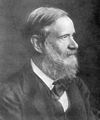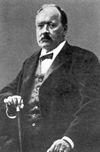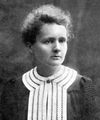
> Quality
of Chemical Measurements
> Europe's Favorite Chemists?
> News and Notices
> Symposia Reports
> New Projects
> Awards and Prizes
> New Books
> Commissions Reports
> Conference
Announcements
> Conference Calendar
Chemistry International
Vol. 23, No. 1
January 2001
Europe's Favorite Chemists? (cont')
Stanislao Cannizzaro
Louis Pasteur
Svante Arrhenius
Marie CurieIntroduction
FECS Millennium Project
Working Party for the History of Chemistry
Final ListChoosing Europe’s Top 100 Chemists: A Difficult Task
Working Party for the History of Chemistry
Thanks to the indefatigable efforts of the chairman of the Working Group for the History of Chemistry, a computer program was set up to collate these 20 lists. Although societies had been asked to grade their own nominations, at this stage mention at any point on someone’s list meant that the individual would be counted. Thus, a single comprehensive table was generated, showing each name nominated with the number of societies giving that person their vote. The winners were at the top, the losers at the bottom. Only two chemists, Lavoisier and Berzelius, scored 100%, with 20 votes each. Few historians of chemistry would quarrel with that result. Yet the total number of names was a formidable 308, and now the matter was firmly in the hands of a nominated committee to come to a conclusion on the matter. All we had to do was to jettison two-thirds of the names proposed!
This committee, which met in Budapest in July 1999, took some fairly obvious steps at the outset. The first task was to eliminate all those who had a score of only one (i.e., had been mentioned by only one of the 20 societies). That immediately brought the numbers down to a manageable 112; to have excluded those who scored two would have taken numbers well below the required 100. But how to eliminate a mere 12 chemists? Far from being a simple task, it proved to be one requiring considerable subtlety and finesse. Each of the 112 contenders was considered individually.
Some were removed because they were not deemed to be "chemists", although the use of "professional" titles raises huge problems before the mid-19th century.
However, Volta as a physicist, Boerhaave as a medical man, and Krebs as a biochemist were deemed to be out of the running. Less contentiously, several names from the 20th century were dropped for the simple reason that their owners were still alive. Yet others disappeared from view because their main chemical work was performed outside Europe. And at this point, the "frozen" 10 lists were considered and a number of their high-scoring extra names were added to the main list. After all the additions and subtractions, we were within two or three names of our target, and almost there.
It would be tedious to recount the last stages of the debate, some of which had to be conducted by post after the committee had risen. By 8 July 1999, the final list had been agreed upon, and all that remained were the fine points of drafting. Lists for the three centuries were arranged in strictly alphabetical order, with no implication of relative merit. Our "100 best chemists" had emerged.
An exercise of this kind is bound to attract criticism. Perhaps the most ironic note of all was struck by one member of the committee who declared that he did not believe in the value of such exercises and would therefore play no part in them (although he remained as an observer). The rest of us, although sharing many of his doubts, still believed that a credible solution could be found, and pressed on accordingly. We were aware that many aspects of the methodology could be attacked, and ourselves had to make some decisions that did not keep strictly to it. Thus, Avogadro, the lawyer, was admitted, but not several worthy names in modern biochemistry.
As often in discussions of this kind, the basic question "What is a chemist?" remains tantalizingly unanswered. Then again, the relative weightings of the three centuries (14/42/44) had more than an element of arbitrariness.
Most seriously, in my opinion, was the ambiguity as to whether contributions to applied chemistry were as valid as those to pure chemistry. The general view seemed to be that they were not, and thus many famous names from the chemical industry are absent. However, Auer, the inventor of the gas-mantle, was considered to have so profoundly affected Victorian society that he is included. Leblanc, whose process founded the alkali industry, does not appear, although his rival inventor Solvay is present. All these cases were subject to much fine-tuning, and reasons could be given (if anyone were sufficiently interested) for each one of them.
So has it all been worthwhile? As a competitive exercise or an end-of-term report, the answer must be decisively "no". We had neither the mandate, the data, nor even the inclination for such a project. Serious work is currently going on that attempts to acquire and organize quantitative data that may go some way to establishing criteria of excellence (among many other things).
It is called prosopography. But this exercise is emphatically not part of that. Our overall conclusion must inevitably be impressionistic rather than precise. What we have recorded is not the value of individuals, but rather public perceptions about them. And these perceptions, of course, depend on many things other than sheer worth.
In terms of national contributions, there are few surprises The "big three"–Germany, the United Kingdom, and France–have, respectively 28, 24, and 15% of the nominations. There is then a large gap until Sweden and Russia each gain 5%, and all the other countries are below that figure. But one hardly needed an exercise of this kind to establish these orders of magnitude.
It would be rather a pity if anyone drew jingoistic conclusions from these data, and even more so if any of the low-scoring countries were to become discouraged.
By all means, engage in critical historical analysis to find what has been conducive to the successful prosecution of chemistry. Some historians of chemistry are already doing just that, and they deserve every encouragement. But do not suppose that this is what we have done.
What has emerged is a list of 100 men and women who have performed distinguished work in European chemistry, have helped to change the physical world that we inhabit, and have been widely recognized by their peers. On the question of peer recognition, the exercise displays another interesting insight. There is a huge gap between an understanding of chemical history gleaned en passant by ordinary chemists in the normal course of their work, and that derived from sustained historical study. It confirms the case for doing everything possible to make the historians’ work accessible to the working chemist. But that is by the way.
The chief function of our labors will, we hope, be to supply a useful tool in the new century’s efforts to foster the public understanding of chemistry. One thing is certain–without a strong human dimension in the communication of chemistry, that task will fail. Perhaps our list will be fuel for the popularizers of science and for chemistry teachers. Making it was fun. If we were to try again next week, we should probably come to about the same conclusions. But it would not be quite the same list.
The views expressed in this article are the author’s own and do not represent an official report of FECS.
The Federation of European Chemical Societies (FECS) is a voluntary association, founded in 1970. It aims to promote cooperation in Europe between those non-profit-making scientific and technical societies in the field of chemistry whose membership consists largely of individual qualified chemists and whose interests include the science and/or practice of chemistry. Information on its activities can be found on the web site <http://www.chemsoc.org/fecs>. Further information about the FECS 100 distinguished European chemists can be found on the web site.

News
and Notices - Organizations and People
- Standing Committees
Divisions
- Projects - Reports
- Publications - Symposia
- AMP - Links
Page last modified 28 December 2000.
Copyright © 1997-2000 International Union of Pure and Applied Chemistry.
Questions or comments about IUPAC, please
contact the Secretariat.
Questions regarding the website, please contact [email protected]




